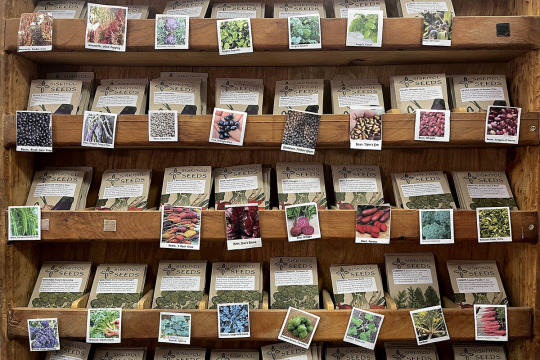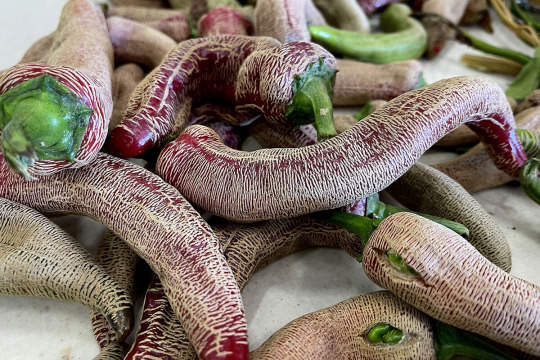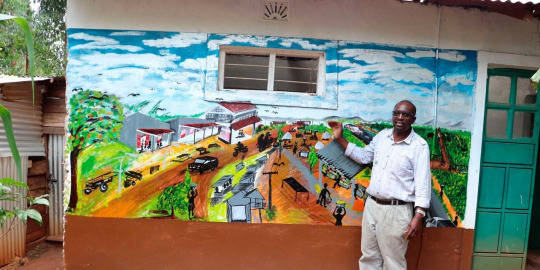#jua kali solarpunk
Explore tagged Tumblr posts
Text
According to Ron Finley, growing regenerative gardens and nurturing soil can transform the world. A former fashion designer turned urban gardener, he is turning unused spaces in Los Angeles into abundant greens to feed, nurture, educate, and build communities.

After realizing that his South Los Angeles neighborhood had an abundance of accessible liquor stores, but purchasing organic produce required a 10-mile walk, he decided to become a “gangsta.” In Finley's perspective, a true gangsta is “having knowledge of how systems work and being able to support yourself.”
Today, Ron Finley's influence extends globally. He has facilitated the creation of numerous community gardens in empty lots around Los Angeles, becoming a prominent voice in the guerilla gardening movement. His efforts include international travel to inspire others, and he teaches a MasterClass on gardening while appearing in documentaries about urban farming, such as Urban Fruit and Can You Dig This.
2K notes
·
View notes
Text
Solarpunk Innovations from Africa
Africans innovate— a lot. To a large extent, it’s because their environments are dysfunctional enough to spur improvisation. When improvisation becomes culture, innovative outliers often emerge. Those outliers, like The Boy Who Harnessed the Wind, permanently move the needle in their communities and, in some cases, the world.
The world seems so busy with the AI hype train. It’s great, but it could make us miss out on the many innovations around us. In 2023, Africa was home to some of the most remarkable and inspiring innovations in various fields, from health to energy and even artificial intelligence. Some of them got recognised, while others are still underhyped. Here are seven innovations from Africa we’re excited about this year.
59 notes
·
View notes
Text
By accepting as inevitable humanity’s demise by its own hand, post-apocalyptic fiction places no responsibility on the living to course correct.
Solarpunk looks towards a post-capitalist future of renewable energy. It rejects climate “doomerism” and shows what our collective future could look like if we heal our relationship with the natural world.
Far from Star Trek’s “full luxury space communism,” where humans race across galaxies via endless sources of energy, the technology in solarpunk is imminently achievable. In the anthology Future Primitive: The New Ecotopias, science fiction writer and democratic socialist Kim Stanley Robinson describes this genre as rejecting “the inevitability of the machine future.”
Instead [solarpunk] asks, “What is the healthiest way to live? What is the most beautiful?”
Rather than Elon Musk’s tent cities on Mars, these fictional worlds “cobble together aspects of the postmodern and the paleolithic, asserting that we might for very good reasons choose to live in ways that resemble in part the ways of our ancestors.”
#solarpunk#solar punk#indigenous knowledge#solarpunk granny#community#jua kali solarpunk#solarpunk aesthetic#activating a solarpunk imagination
735 notes
·
View notes
Text
Seed enthusiasts can be motivated by food independence or climate change resilience or just the desire to grow – and taste – a really great watermelon. But what ties them together, says Bevin Cohen, a leader in the heirloom seed movement who organized the expo’s seed swap, is the joy of joining with others to grow a better future.

And heritage seeds are particularly valuable for biodiversity, seed experts say. These types of seeds are naturally pollinated and have been passed down from one generation to the next, traced back for at least 50 years.

Rezha Macedonian peppers sit on a table at the National Heirloom Exposition in Ventura, California, Sept. 10, 2024. Rezha, which means “engraved,” references the distinctive lines that fill the long, spicy pepper. They are grown in small batches from heirloom seeds from North Macedonia.
Rebecca Newburn founded the Seed Library Network to help consolidate these efforts, with seed packets available everywhere from universities to neighborhood Little Free Library boxes. The interest, she says, has been “growing and growing” since she developed the idea in the late 2000s. Last year, more than 2,200 people from 35 countries registered for the online Seed Library Network summit.
“People come to seeds from different places and connect to them in different ways,” Ms. Newburn says.
Some growers are worried about climate change, she says, and want to test out varieties that might fare better in a hotter, drier, or wetter environment. Others worry about corporations controlling so much of the food supply.
#solarpunk#solar punk#community#indigenous knowledge#jua kali solarpunk#solarpunk gardening#heirloom seeds#seed swaps#biodiversity#agroecology
199 notes
·
View notes
Text
"The young urban farmers I interviewed are using community gardens to grow more than vegetables. They’re also nurturing social connections, creating economic and business opportunities, and promoting environmental conservation. My findings highlight the transformative potential of youth-driven urban agriculture and how it can be a multifaceted response to urban challenges"
#solarpunk#solar punk#community#africa#jua kali solarpunk#informal economy#cape town#youth#solarpunk AF
63 notes
·
View notes
Text
Treasures of nature
In New Zealand, the Māori people have long regarded freshwater ecosystems as taonga (treasures) deeply connected to their identity. Their traditional ecological knowledge, or mātauranga Māori, prioritises the health and restoration of rivers, lakes and wetlands. Perhaps one of the most groundbreaking examples of Indigenous-led conservation hails from the Whanganui River (Te Awa Tupua).
As we face growing threats to freshwater species and habitats worldwide, integrating Indigenous knowledge with modern science presents an unparalleled opportunity for change and growth.
After British colonials arrived in New Zealand in the 1800s, industrialisation of the Whanganui River began. Long treasured by generations of Indigenous Māori, over time the river became polluted by increased land clearances and litter. The sacred water source of the Māori was under threat. The river begins its journey from the snowy climes of the Mount Tongariro volcano, travelling a 180 mile (290 km) stretch through the luscious New Zealand countryside until it meets the open plains of the Tasman Sea.
Revered for centuries by locals, the Whanganui tribes adopt their namesake, spirit and even strength from its waters. In fact, in 2017, it became the first river in the world to be recognised as a legal person, closing the chapter on one of New Zealand’s longest court cases.
Through this legal framework, the Māori and the New Zealand government now co-manage the river’s health, blending traditional practices with modern science, the ruling inspiring similar action for other environments across the globe, encouraging other communities to advocate for their own sacred spaces.
39 notes
·
View notes
Text
Learning from the land: Using indigenous knowledge for climate-sensitive circular lifestyles
Indigenous techniques like natural resource renewal, tree-based farming, traditional mud-and-wood housing, and consuming local, uncultivated foods, can address some aspects of climate change and also bring about a sense of responsibility and connection with nature. Promoting agroforestry and integrating trees into farms can improve biodiversity and soil health. Adopting drought-resistant crops and traditional methods like rainwater harvesting, mulching, and using organic manure is vital for conserving moisture, enhancing soil fertility, and minimising external inputs. Building on these approaches, there is a powerful social dimension that further amplifies their impact.
But before proposing viable solutions, we need meticulous landscape mapping: understanding community environments, traditional knowledge systems, and specific vulnerabilities. Fully understanding these dimensions can pinpoint exact strategies to reduce our ecological footprint, and promote lifestyles that minimise electricity consumption and resource use, while drawing on ancient wisdom to enhance our modern lives.
58 notes
·
View notes
Text
Agroecology is far more than a set of sustainable agricultural practices
Agroecology puts peasants and indigenous voices at the center. It seeks to preserve biocultural diversity and strengthen resilience while challenging existing power structures in the food system.

The ever-busy schedule at the Bio-Gardening Innovations (Biogi), a hands-on farmer training centre in Elununi, Vihiga County is a clear testament of how smallholder farmers are eager to learn about techniques that can help them remain productive despite the changing climatic conditions.
According to Ferdinand Wafula, the founder and coordinator of the training centre, farmers from Vihiga, and as far as Kakamega and Nandi counties, have been streaming in every week to learn about regenerating seeds so as to maintain unique traits and adaptability to local climates, health and fertility of soil through the use of ecological farming practices, and to mingle with other farmers from different parts of the region.
“We support smallholder farmers in transitioning to ecological farming systems by employing principles of agroecology, and we teach them about designing permaculture units that are both productive and sustainable, integrating crops and vegetative cover to create resilient ecosystems,” said Wafula.
Agroecology, an approach that blends ecological science with traditional farming knowledge, is emerging as a sustainable solution to the multiple challenges faced by agriculture today—rising input costs, soil degradation, water scarcity, and growing climate risks. By reducing reliance on chemical fertilisers and pesticides, promoting crop diversity, and prioritising soil health, agroecology offers a way forward that benefits both farmers and the environment.
“Agroecology is not just about growing food; it’s about rethinking the entire food system,”
#solarpunk#solar punk#indigenous knowledge#jua kali solarpunk#informal economy#africa#community#global south#agroecology#global north#future of farming#future of agriculture
19 notes
·
View notes
Text
“In most African mountains, there are no meteorological stations or long-term records of crop yields,”
Researchers have now interviewed 1,500 smallholder farmers from ten mountain regions in eight countries across equatorial Africa: Cameroon, Ethiopia, Uganda, Rwanda, Burundi, Democratic Republic of Congo, Kenya, and Tanzania.

Aida Cuni-Sanchez is a researcher at the Norwegian University of Life Sciences (NMBU), and was the the lead researcher for the new study published in Nature Climate Change.
In the absence of historical data, the researchers recorded the farmers’ experiences and indigenous knowledge to build a record of past changes.
They found that climate change has affected the environment in multiple ways.

How can mountain communities adapt to climate change?
The study revealed that mountain communities have changed their farming practices in response to the changes in their environment.
These changes include adopting new crop varieties and investing in alternative ways to manage water resources and soil erosion. Farmers have also increased their use of agrochemicals. Some are investing in more veterinary care for their livestock.
Whilst similar effects of climate change were reported across all ten mountain regions studied, the ways the farmers try to adapt to these changes differed.
The researchers note that a universal 'one-size-fits-all' approach to addressing the consequences of climate change should be avoided.
#solarpunk#solar punk#community#indigenous knowledge#africa#reculture#informal economy#jua kali solarpunk#climate change#adaptation#DIY#mountains
25 notes
·
View notes
Text
The shelters, called "X-Wings," are made of four containers in an "X" configuration. Each container has multiple sleeping compartments with a bed (or two, in double rooms), desk, outlet and storage shelves. Each room is individually air conditioned.
The entire unit is solar powered so it doesn’t need to be connected to the electric grid, making it easy to move where needed.
The unit doesn't have bathrooms or kitchens, so it needs to be near a facility that does.
"We're all architects and have been doing traditional buildings for 30 years now. No project that I've ever been involved with feels as good as this one," said Steel + Spark lead architect Zach Burns.
32 notes
·
View notes
Text

Beginning her career as an environmental engineer who designed rural and city water supply systems, Ismawati switched careers when she realized that the work she was doing wasn’t helping those most in need. She decided to redirect her expertise to design safe waste management initiatives, founding her own NGO.
BaliFokus is a community-based urban environmental management program that partnered with a rookie trash company collecting trash from nearby hotels. Ismawati taught sustainable waste management techniques and those that initially picked up trash for pigs learned how to professionally process trash.
This not only helped the environment but improved businesses where they went from having to pay for waste removal to being paid as waste managers. This also increased the number of employees and reduced waste by almost 70%
37 notes
·
View notes
Text

The floating homes of Lake Titicaca
Created by the indigenous Uros people as protection against attacks from the Incas, the Uros Islands are one of the world's most innovative feats of human engineering.
The man-made floating islets, which are home to the indigenous Uros people, are created by stacking layers upon layers of totora roots and reeds. This water-resistant plant grows in the lake and is the lifeblood of the Uros community: it is used to make boats, houses, roofs, mattresses and more. The plant is also eaten (playfully called the "lake banana") and applied as medicine, and its flowers are used to make tea.
"There was something very haunting and appealing about this wide array of creation from a single material," said Amorós, whose art often draws inspiration from Peruvian cultural legacies and communities.

"The structure of the totora is cellular. It's a very hearty, stable material that's also flexible but prevents kinking," explained Vranich. "People often used to make skis with just a single piece of wood. Nowadays, they replicate the interior form of a cross-section of totora."
To build the islands, each of which is home to two to six families, the Uros first gather large blocks of totora roots, which often float to the surface during the rainy season. Multiple blocks are pulled together, and the roots and reeds mix naturally to form a layer about 1-2m thick, called khili.

To make sure the islands do not drift away, eucalyptus rods are stuck into the bottom of the lake as anchors and are tied to the root blocks using rope. Every 15 to 20 days, the totora reeds rot and need to be replenished with fresh ones. It's a laborious, endless cycle that is essential to the islands and the Uros' survival on them. "What struck me the most was how the islands and homes are in a constant state of flux, of creation and decay," said Amorós. "This ephemerality is magical."

Today, solar panels power bedroom lights and small TVs; a radio station operates on the main island; and Uros offer their homes or private hospedajes (lodges) on Airbnb.
"They already have called us from Lima, saying that we're in the process of becoming an official wonder of the world," he said.
Whether or not that happens, it's evident that these modern changes and tourism have altered the Uros' life on the lake. One thing remains certain, though: as long as there is totora growing at Lake Titicaca, the islands' rooted foundation will stay the same.
BBC
#solarpunk#solar punk#indigenous knowledge#community#jua kali solarpunk#reculture#solarpunk aesthetic#informal economy#peru#lake titicaca#living islands#cycles of life#sustainable architecture#renewable housing
40 notes
·
View notes
Text
“If we used to use oil-powered machines to flow water from irrigation canals to your fields, now we power it with electricity from sunlight. Free electricity from the sun so we can provide free irrigation,” said Marcos Jr at the inauguration ceremony. “Certainly because of the construction of this solar-powered pump irrigation project, in your barangay there will be a continuous flow of water in the irrigation systems, crops will be well taken care of, your harvests will increase, double to the product.”

The project is the first in the Philippines to be constructed over an irrigation canal, meaning that the land cultivated by farmers will not be reduced.
#solarpunk#solar punk#jua kali solarpunk#community#informal economy#solar power#solar power irrigation#philippines#canal top solar
40 notes
·
View notes
Text
Solarpunk is a futurist movement that began in speculative fiction and sci-fi films and has since spread to architecture and design. Practitioners envision a clean and green future built on principles of sustainability, social justice, and collective action.
The name spells it out.
"Solar" signals optimism and a strong association with renewable energy, while "punk" reflects a DIY ethos and an anti-capitalist philosophy.
33 notes
·
View notes
Text
Food, energy and water insecurity are ongoing concerns in East Africa, agrivoltaic systems address all three

This paper shows data for agrivoltaic systems in Tanzania and Kenya that generate power, produce food and conserve water, demonstrating their viability for both grid-tied agribusinesses and rural, off-grid projects.
The research indicates that certain crops such as maize, Swiss chard and beans thrived in the partial shade offered by solar panels.
“The positive yield results for Swiss chard have promising implications for growing nutritious crops with agrivoltaics. The control plot was sufficiently irrigated, with yields comparable to those in a rainfed study in South Africa, so drought stress does not explain the lower yields compared to the agrivoltaic plot.
“Instead, the partial panel cover is potentially creating a more suitable growing environment by protecting the crops from heat stress and/or UV damage,” the report said.
It notes that some crops produced more food using less water, “valuable in a region where water scarcity threatens food security, most farmers rely on rainfall for their crops, and climate change is likely to make rainfall less predictable.”
#solarpunk#solar punk#indigenous knowledge#community#africa#jua kali solarpunk#informal economy#agrivoltaics#solar power#agriculture
19 notes
·
View notes
Text

Nigerian Inventor Samuel Yakubu Is Lighting Up Homes With Simple Salt and Water Solution
Yakubu said his WATTer Lamp evolved from being powered with kerosene, unripe fruits and rechargeable batteries to ordinary salt and water.
The lamp uses a light-emitting diode (LED), which provides the light once the salt and water solution has been added. This solution, a mixture of one teaspoon of salt and water, can last up to 70 days before it is replaced.

Yakubu is hoping to produce powerbanks that use the same salt and water solution to charge mobile phones. He also hopes to set up his factory in Nigeria so he won’t have to always send his raw materials to China.
Source
#solarpunk#solarpunk business#africa#jua kali solarpunk#salt and water#renewable energy#nigeria#inventor
31 notes
·
View notes